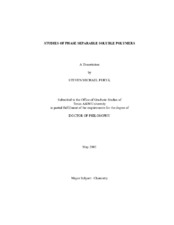| dc.description.abstract | The technique of phase labeling has the ability to greatly enhance synthetic
protocol by simplifying purification and increasing efficiency. Traditional insoluble
supports offer efficient and simple recovery of the “phase tagged” material but suffer
from problems inherent to their heterogeneous nature. A solution to these problems has
been to utilize phase separable soluble polymers in the design of “smart” responsive
systems that offer the option of homogenous reaction conditions with heterogeneous
separation conditions. The subject of this dissertation focuses on the application of
soluble polymeric phase tags in systems where the miscibility between solid-liquid and
liquid-liquid systems is thermally induced.
Low molecular weight poly(ethylene glycol) (PEG) oligomers were investigated
as phase anchors for SCS palladacycle catalysts. The oligomeric PEG chains were
sufficient to engender polar phase solubility in a heptane-DMA thermomorphic system.
Microwave irradiation of these thermomorphic mixtures of palladium complexes and
substrates was a viable scheme to recycle and significantly shorten reaction times for
simple Heck reactions of aryl iodides. Soluble polymeric supports possessing a lower critical solution temperature
(LCST) were utilized in the sequestration of the S-triazine herbicide, atrazine, from
contaminated water samples. The ability of poly(N-isopropylacrylamide) to sequester
hydrophobic guests like atrazine was examined. A functionalized PNIPAM derivative
containing secondary cyclic amines exhibited superior sequestration ability that was
credited to the covalent binding of the atrazine.
In order to facilitate the design of tailored, thermally responsive, smart polymers,
a high throughput temperature gradient microfluidic device was used to obtain LCST
data in a fast, accurate manner. The specific ion effects of various alkali metal halide
salts on the LCST of PNIPAM were investigated. The high precision in the
measurements enabled more subtle effects such as changes in solvent isotope, polymer
microstructure, molecular weight, and importance of end group effects on the LCST of
poly(N-alkylacrylamide)s to be evaluated. | en |


